Applications in Sports
Applications in Sports
Statistical Extraction Method for Revealing Key Factors from Posture before Initiating Successful Throwing Technique in Judo
Statistical Extraction Method for Revealing Key Factors from Posture before Initiating Successful Throwing Technique in Judo
【 Research Outline 】
Many methods such as biomechanics and coaching have been proposed to help people learn a certain movement. There have been proposals for methods to discover characteristics of movement based on information obtained from videos and sensors. Especially in sports, it is expected that these methods can provide hints to improve movement skills. However, conventional methods focus on individual movements, and do not consider cases where external factors influence the movement, such as combat sports. In this paper, we propose a novel method called the Extraction for Successful Movement method (XSM method). Applying the method, this paper focuses on throwing techniques in judo to discover key factors that induce successful throwing from the postures right before initiating the throwing techniques. We define candidate factors by observing the video scenes where the throwing techniques are successfully performed. The method demonstrates the significance of the key factors according to the predominance of factors by χ2 test and residual analysis. Applying the XSM method to the dataset obtained from the videos of the Judo World Championships, we demonstrate the validity of the method with discussing the key factors related to the successful throwing techniques.
1. Research backgrounds
Recent modern training is based on observing target movements from videos. The trend is considered as one of the most important training methods to let the learners understand their own movements. However, these training methods have the problem that due to one’s subjectivity and coach’s biased interpretation by the diversity of a player’s physical characteristics and their condition, it cannot be standardized. Therefore, to eliminate this problem, methods to measure skills objectively by using inertial sensors have been researched. However, these conventional methods do not consider the external force on the motor subject, and focus on the individual’s motor ability. there exists a problem that these methods are not applicable to combat sports such as judo, wrestling, boxing etc. These combat sports include interactions between players.
This research project proposes a novel method that derives key factors for effective learning of a movement in combat sports. We will focus on judo as a high-impact example of combat sports and propose a method to derive the key factors for successful throwing techniques. In this research project, we will focus on postures before successful throwing techniques. Then, we propose a statistical method. The method will derive the key factors that induce successful throwing techniques from the posture right before the throwing techniques.
2. Research outcomes
We select as many candidate factors of a successful throwing as possible from the throw(called Tori) positions and the throwee(called Uke)positions. We also define the types of throwing techniques as the successful movements and the candidate actions that lead to a successful throw as the candidate factors. And We obtain datasets that contains the types of successful movements, candidate factors and attributes, and analyze the datasets from the video database.
Then, we analyzes the correlations among the successful movements and the candidate factors by χ2 test. By this analyzing, we can find the successful factors from the candidate factors.
As a dataset of the scenes that include the throwing techniques, we will use the video database recorded in the World Judo Championships available from the IJF website. We collected 781 successful scenes of single throwing techniques except counter and combinational ones. By the XSM method analysis for the dataset, we find the successful factors from postures before initiating a successful movement. And we find differences among groups by projecting a subset of the dataset against attributes (gender difference, weight class, etc.).
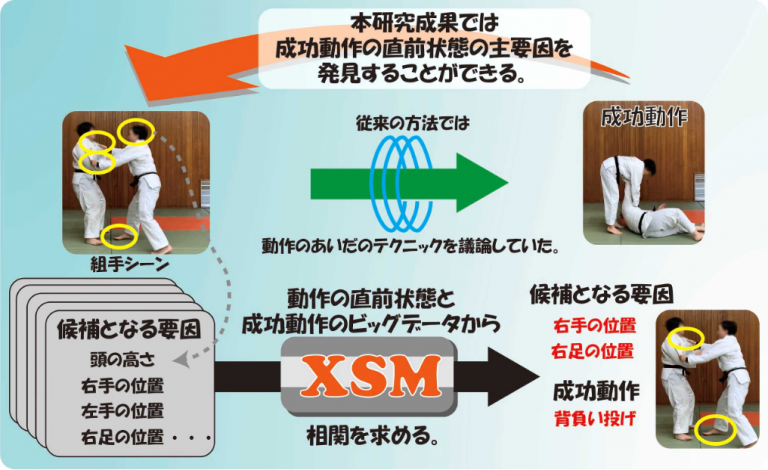
3.Research articles in Journals and Magazines
Satoshi Kato and Shinichi Yamagiwa, Statistical Extraction Method for Revealing Key Factors from Posture before Initiating Successful Throwing Technique in Judo, Sensors, 5884, (2021-09-01), DOI:10.3390/s21175884
4.Funding
This research is supported in part by JST PRESTO Grant Number JPMJPR203A.
Exploring Possibility of Skill Scoring using Motion Sensory BigData
Exploring Possibility of Skill Scoring using Motion Sensory BigData
【 Research Outline 】
The popular applications in the sports market have been using human movement data acquired by small sensors. The conventional biomechanics and sports science field define human movement by mathematical average model derived from featured points of the movement. Parameters selected from the model are applied to the final model provision. However, if the model can be found without applying such parameters, breakthrough can be provided to the new movement analysis method that accelerates health management and skill analysis. This research project applies a machine learning approach to human movement bigdata such as movies and sensor data recorded from human movement and tries to find a new method that automatically build a skill model.
1. Research backgrounds
(1) Applications to sports and healthcare using motion data are in fashion
We can find systems that analyze motion data from sensors such as accelerometer and gyro. For example, Nike + that judges jogging and miCoach of Adidas are typical, and OMRON has released a posture meter that judges walking skill. In this way, movement data can be used for self-evaluation of training and judgment of skill level, and is widely used by people who enjoy sports.
(2) The conventional motion prediction / skill judgment method applies individual parameters to the average model of motion.
However, since the systems using the sensor as described above add the parameters for individuals to the average model established in the fields such as biomechanics and motor learning, it is necessary to standardize the parameters. There is a difficulty such as an increase in error in medium- to long-term movement prediction.
(3)The method of predicting movement in the near future in the medium to long term lacks a decisive hit
Akitomo Kaneko’s “Tradition of Techniques”, Koichi Furukawa’s “Physical Knowledge”, Kumiko Ikuta’s “Waza Language”, etc. have tried to find breakthrough. The motion prediction system is not found yet. The problem is that the judgment of “movement in the near future” is left to the user’s self-judgment.
2. Research objective
In this research, as shown in Fig. 1, as a new approach to the conventional method of customizing the average model, we discovered the mechanism of skill from big data of movements in which information on all movements is latent, and “in the near future on a year-month basis”. Is it possible to predict “movement”? We challenge to find the answer. In other words,
(1) Is it possible to specify the skill level?
(2) Is it possible to predict movements for skill acquisition?
The solution to these two questions is derived from data analysis using intelligent information processing, and we aim to develop a self-growth training system whose accuracy improves.
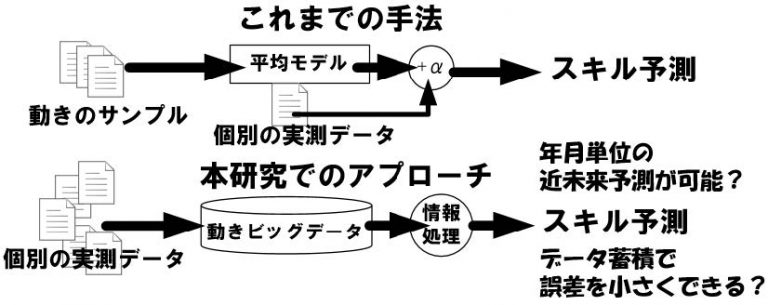
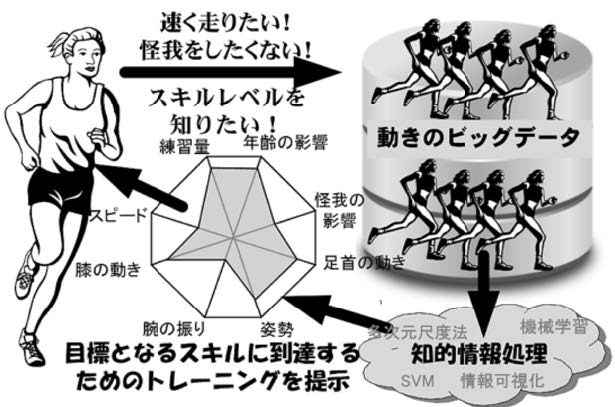
FIGURE1:Research objective
3. Research outcomes
(1)Development of skill grouping method
In this research, we have developed a mechanism “skill grouping” that derives the skill “score” using “movement big data” that collects a lot of movement data. We have developed a system that guides users to approach their ideal movements and a technical platform that provides the services. The movement data can be collected during daily life by even a smartphone with a motion sensor. It will be a familiar technology and can collect a lot of motion data. Therefore, by using motion big data in a timeline, the method can absorb the bias for statistical values.
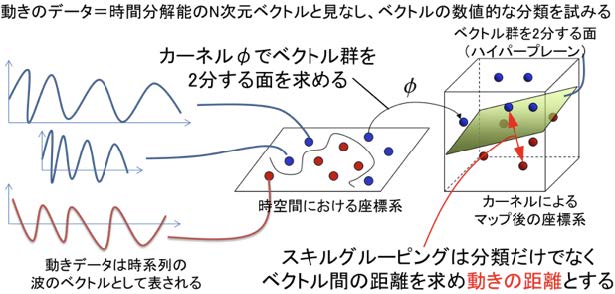
FIGURE2:Classification of data by the kernel method
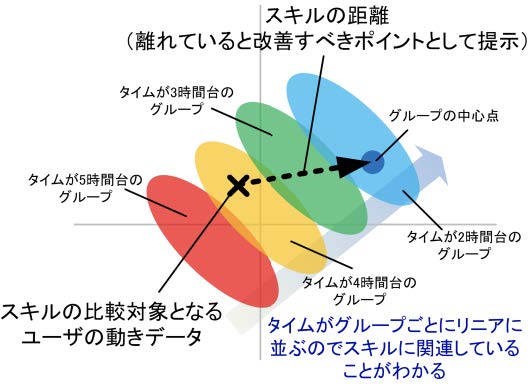
FIGURE3:Skill-related distribution
In the skill grouping method, when the user makes a comparison with an expert, we wondered if it would be possible to find the mathematical distance of the motion data. Therefore, as shown in Fig. 2, the “distance of movement” is derived by a calculation for determining the distance between the classified data by the kernel method, which divides the similarity of data into two. At this time, as shown in Fig. 3, if a group is created with attributes related to skills such as marathon time, the movements of parts related to skills are distributed linearly. Skill grouping not only automatically discovers parts related to such skills, but also the movement data of related parts is displayed as an index for skill acquisition, and after sending movement data from a terminal such as a smartphone. , By processing the above processing on the server and returning the score, it is possible to provide a new service that automatically provides coaching.
(2)Demonstration experiment of skill analysis
As a proof experiment, with the cooperation of Mizuno Corporation, we conducted to analyze the skills for improving the marathon time by skill grouping and find the effect of the method. As shown in Fig. 4, the running motion is obtained from the images taken by the high-speed camera of the three-dimensional positions of the markers attached to six places on the body. When the three-dimensional position of each marker is applied to skill grouping, we found the important points in the elbows, knees, and ankles as the keys to increase the marathon time. The skill distances of each runner’s movements linearly change with the time. From the movement big data of these three points, the degree of influence on the time (a numerical value that becomes 100 when the time is far from the good group.) is shown on the radar chart as shown in Fig. 5 for the skill. In the form of the degree of influence, we demonstrated the possibility of constructing a service that shows the points to be seen when approaching the movement of the target.
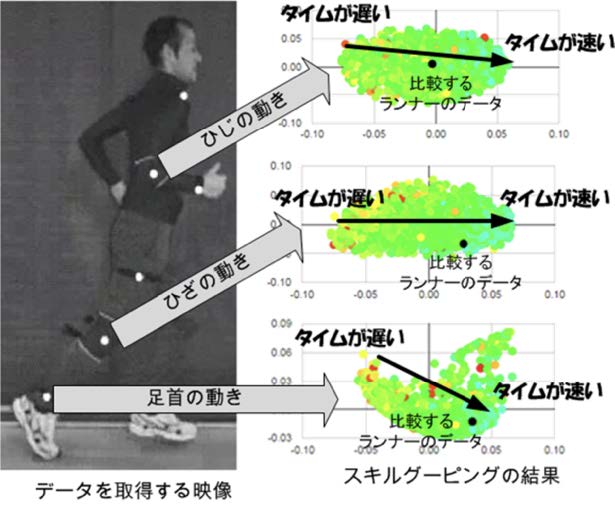
FIGURE4:Demonstration for running skill
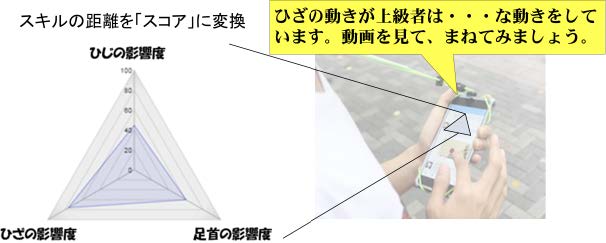
FIGURE5:Service example that presents skills
(3)Demonstration experiment for conditioning application
In the ski skill certification (so-called badge test), the judges evaluate the skills by the perspectives. We wondered if it would be possible to automate the evaluation with a computer, and applied skill grouping to the parallel turns of skis to develop a ski training system. As shown in Fig. 6, during the demonstration experiment, three beginners and three experts were asked to carry their smartphones on their backs, and their accelerometers were used to collect the movements of parallel turns and apply the data to skill grouping. In the graph of Figure 6, the eight attempts of each experiment participant are plotted as the same line for each person. The different distributions of experts and beginners represent the skill differences, but the eight trials of each skiers are plotted in the narrow range for the experts and the large range for beginners. In other words, it turns out that experts can used to follow the snow surface in the same way in any slope, but beginners do not. Therefore, it was demonstrated that it is possible to provide a conditioning service to check whether the skill is improved by using it as a material that can judge whether the skier performs always the same movement or not.
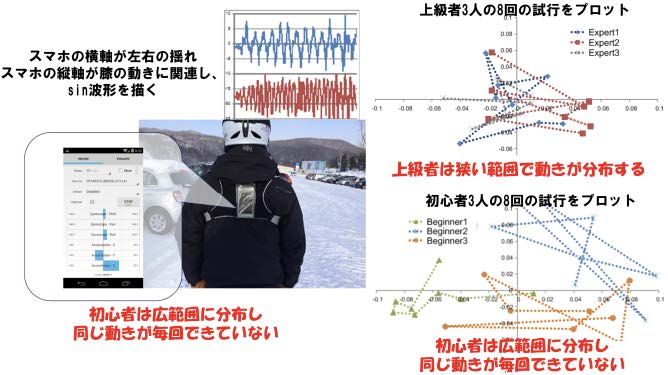
FIGURE6:Demonstration experiment of conditioning
(4)Demonstration experiment for motion analysis of tool differences
Furthermore, in a baseball bat swing, as shown in Fig. 7, an accelerometer / gyro sensor was attached to the bottom of the bat, and the movement of tee batting was acquired from professional and amateur players. The skill grouping was applied to the dataset. At this time, the types of bats were metal and wooden, and the same player was asked to swing them, and the results were compared.
The labels A4 and A5 in the graph in Figure 7 are IDs that identify players. They are plotted in different positions when different bats are used. In other words, the difference of tools induces a difference in skill, which means that the batting motion changes. From this experiment, it is demonstrated that a tool fitting service that automatically determines the fit to the user’s body can be developed by quantifying the difference between tools by the skill grouping.
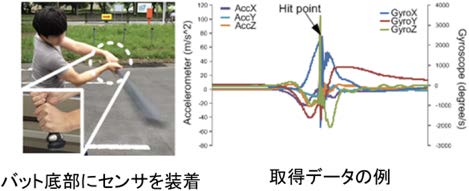
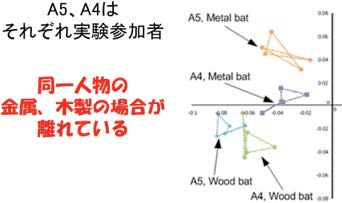
FIGURE7:Demonstration of motion analysis of tool differences
4.Publications
- Shinichi Yamagiwa, Yoshinobu Kawahara, Noriyuki Tabuchi, Yoshinobu Watanabe and Takeshi Naruo, Skill Grouping Method: Mining and Clustering Skill Differences from Body Movement BigData, In Proceeding of International conference on BigData 2015, pp. 2525 – 2534, IEEE, October 2015.
Development of a skill learning system for advanced body balance control by sound feedback
Development of a skill learning system for advanced body balance control by sound feedback
【 Research outline 】
A new era has come when body control is captured by a small sensor. This research promoted a challenging research theme that investigates if sound feedback can control body balance or not. This research challenged to find the potential relationship of human between the auditory and the body balance experimentally. The research developed a system that translates data from accelerometer to the feedback sound, and then evaluated the validity of the system.
1.Background at the beginning of research
The time has come when it is possible to develop a palm-sized system that records human behavior in millisecond intervals using highly integrated sensors such as acceleration, geomagnetism, and gyro. There is a possibility that the sensor will be worn by a human and the obtained data will be fed back to lead to the next operation. In this study, we focus on the effect of sound stimulus on human motor control and discover whether the body balance can be controlled by converting the sensor output into sound and feeding it back. There are two possible controllable methods: control by sound stimulus to the potential motor ability of humans, and control by relying on sound by learning sound stimulus, and a flexible high-performance sensor system. Focusing on development, we will conduct experiments and explore the principle and mechanism.
(1) Sensors progresses due to the development of nanotechnology
With the development of nanotechnology, especially micromachine technology, sensors that can observe directions, movement speeds, and postures, are available for observing human behavior such as acceleration, gyro, and geomagnetism. Those can be packed into LSIs about the size of a fingertip. The time has come when the sensor LSI manufacturers are searching for ways to use it.
(2) The time has come when sensors can be embedded and data can be fed back in real time.
The most promising way to use it is to carry around an ultra-small sensor, feed back the data obtained from the sensor to humans, and reflect it in the next action. Since the sensor is small and can be carried around at all times, it is expected to be applied to health care, sports training and rehabilitation.
(3) There are problems with traditional sports training and rehabilitation in the feedback techniques
There is a conventional technology that feeds back and connects it to the next operation. For example, control is performed by direct electrical stimulation of muscles, and balance sensation is controlled by vestibular electrical stimulation. It is difficult to put it into practical use due to concerns about physical effects, long latency to perception, and only rough control of front and back, left and right.
The advanced studies related to this research project include body balance control by vestibular electrical stimulation. It is known that direct electrical stimulation can affect body balance. However, no matter how safe it is, the ethical discomfort with direct electrical stimulation causes anxiety for rehabilitating patients and sports athletes. In addition, treatment methods using auditory rhythm input for patients with intractable diseases have been proposed. Effective results have been shown. However, controlling the physical balance of healthy subjects with simple auditory stimuli has been attempted at the level of basic research. However, The way that accelerometer data is converted into sound is still no attempt to derive the next movement from the potential athletic ability by giving feedback.
Many attempts have been made to control body balance by the illusion of visual feedback. However, there are still many mysteries about voice-based ones, and many of them have not been clarified. The effect of human motor on latent motor capacity through auditory feedback. It will be discovered in this study. And it is a challenge to develop a new theory of physical control.
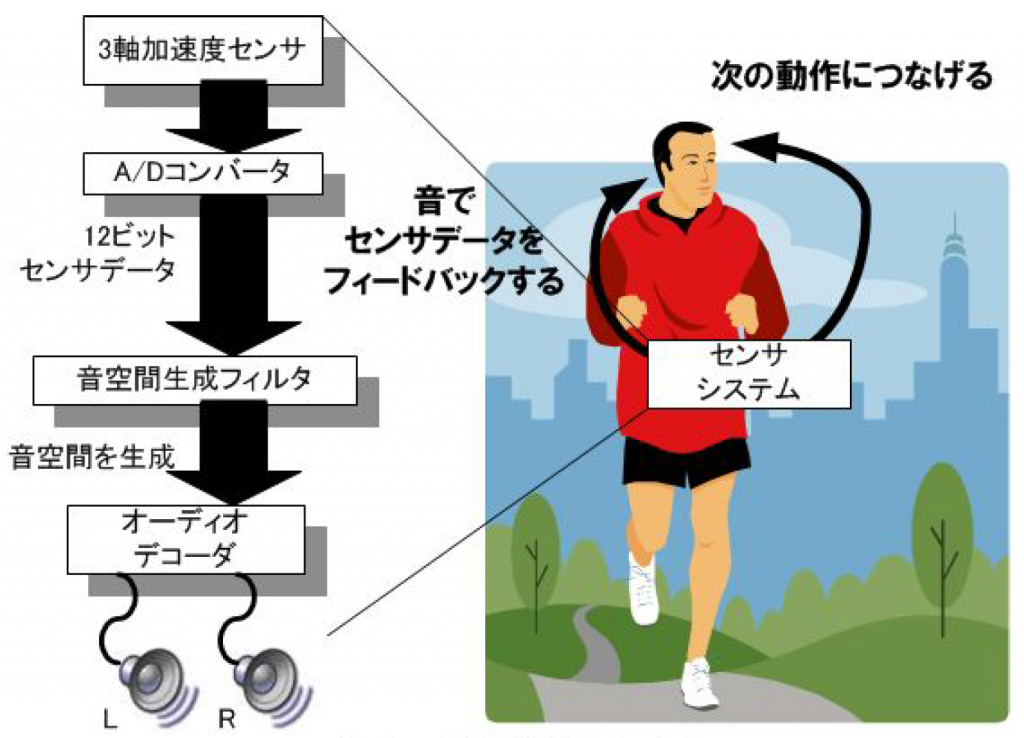
FIGURE1:Aim of this research
Sound feedback of sensor data
2. Research objectives
a) Research aim
In this research, we have a question: Can the body balance be controlled by converting the acceleration sensor data into sound and feeding it back as shown in Fig. 1? In other words, the sound feedback that accompanies exercise explores the facts of the following two questions.
① Can it affect your potential athletic performance?
② Is it possible to control the body by learning sound stimulation?
We will set two themes, and explore whether that fact exists. Specifically, we will elucidate based on experiments, focusing on the development of a sensor system that can convert sensor data to sound at high speed and change the type of sound.
b) New principles explored in this research
There are two methods of posture control considered in this study. The first is a method to derive human motor ability by inducing an illusion from auditory stimulus. For example, if a sound is input to the right ear of a person who is going straight, it is expected that the effect of turning to the left or right can be obtained. If this principle can be discovered, the technology for rehabilitation systems that feed back sound will improve drastically. The second is a method to guide human’s posture by the sound. In this method, the subject is trained to consciously follow the sound source, the next posture is induced by the sound. The sound is converted from the sensor data.
From the above two methodologies, the following principles are expected.
(New principle 1) Auditory stimulation by sound feedback affects the potential motor ability of humans.
(New principle 2) Body balance can be controlled by learning to follow sounds.
The purpose of this research is to change the body balance control when these two principles are combined and the learning progresses to a higher degree.
c) Expected results
Our first aim is (New Principle 1), but even if it cannot be discovered, we hope that the following results will be obtained according to (New Principle 2).
(1) Can we develop a rehabilitation system that directly induce the human posture ?
We expect a rehabilitation system that does not require equipment such as electrodes that are directly attached to the human body. Simply attach a small sensor system to our body and listen to the sound to receive a medical examination program, enabling home treatment.
(2) A system to avoid dangers such as falls of the elderly can be created
It can be applied to a pre-risk avoidance system that analyzes the sensor data pattern immediately before sound feedback and outputs a posture correction warning by voice when it matches the fall pattern of the elderly.
(3) Expected to be applied to sports training
A system that corrects athletes’ wrong movement and the habits using real-time sensor data can be developed. In addition, it is expected that the era will come when elementary and junior high school students will improve their sports techniques using the data of top athletes according to (New Principle 2).
(4) Assist system for the blind people can be developed
By integrating video input such as a stereo camera with data from an accelerometer, it is possible to develop an assist system that expands the range of action for the blind people. For example, the step at your feet is notified by sound to avoid danger.
(5) Can be applied to entertainment called "sound game"
It can be applied to games played with sound and can be used in the entertainment industry.
3. Research outcomes
The results obtained by this study can be classified into (i) basic human motor ability of body balance control for hearing, (ii) motor learning when voice is fed back, and body balance control. Each will be described below.
(1) Sound guidance differs depending on the type of change in the sound.
Guidance by the potential ability of body balance control by sound was impossible as described above, but as a result of conducting an experiment on Fig. 3 (b) that consciously pursues sound stimuli, changes in sound that change from side to side. Therefore, it was discovered that the amount of rotation for changing the direction of travel differs depending on the method of changing the sound when the walking direction is followed.In this experiment, the pan was changed from side to side by the sound stimulus, and an experiment was conducted to follow it. The method of the change was divided into a sigmoid function and a heaviside function, and these were randomly presented to the participants. At that time, the case of using the Heaviside function (when the sound changes from side to side in a rectangle) is better than the case of sound change using the sigmoid function (that is, when the sound moves gently from side to side). It turned out that the amount of rotation was large. This is an application that guides you to chase the voice (for example, rehabilitation), and when you want to control the amount of rotation of the body, change the pan with the heaviside function to induce more body movement. It can be expected that applications such as, will be possible.
(2) We found that sound-based body balance control is related to vision.
In this result, we found that the reaction time to sound stimuli was short when visual perception was obtained. In other words, it was clarified that the balance control by the auditory stimulus is also related to the visual information, and that the visual information helps to make a high-speed reaction.
(3) No motor learning ability by sound could be found.
According to the experiments, we have confirmed that it is impossible to improve the accuracy of body balance control by learning exercise by sound, that is, by obtaining the same sound stimulus.
(2)It turns out that the sound feedback system has engineering challenges.
We have developed a test system that feeds back sound from motion data (sensor data). Figure 4 shows the picture. In this system, the data from accelerometer can be converted into 440 Hz sound and output it to earphones. However, when a feedback experiment using this system was performed, two major problems were revealed. The first is that the delay that converts sensor data to sound data is inevitable with modern embedded system technology (that is, software processing), and it is necessary to predict the timings. However, it is impossible to predict and create data for the timings that have not yet occurred. Therefore, it is still necessary to develop computing technology with computing power that enables high-speed, real-time data conversion.
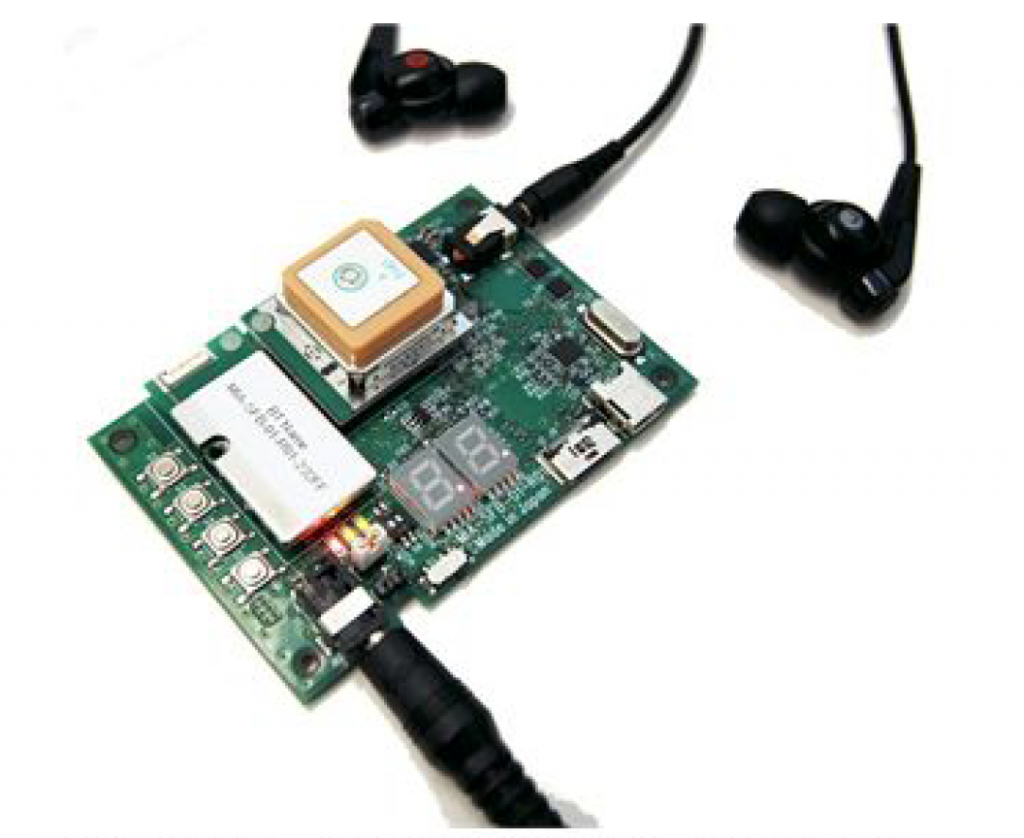
FIGURE4:Experimental system with sound feedback function
5.Related papers
- Shinichi Yamagiwa, Naka Gotoda and Yuji Yamamoto, Space Perception by Acoustic Cues Influences Auditory-induced Body Balance Control, icSports: International Congress on Sports Science Research and Technology Sports 2013, September 2013, Portugal